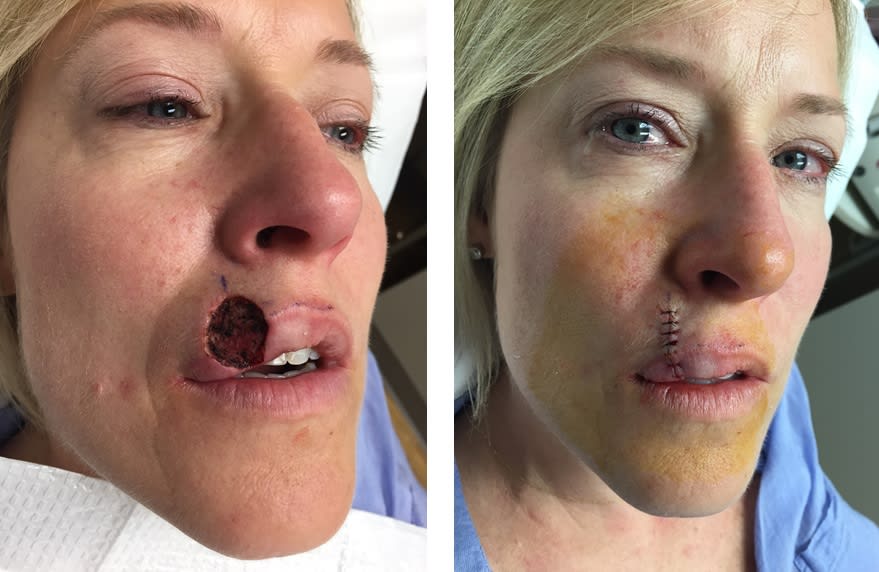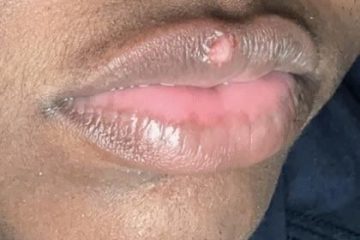To determine if you have skin cancer on your lip, look for persistent sores or spots that don’t heal. Unusual changes in lip coloration or texture can also be indicators.
Detecting skin cancer early can dramatically improve treatment outcomes. Your lips, though often overlooked, are vulnerable to the sun’s harmful UV rays, just like other parts of your skin. Being vigilant about changes on your lips is crucial. Persistent sores, particularly those that bleed or don’t heal, can be warning signs of skin cancer.
Other symptoms might include noticeable changes in the color or texture of your lip skin, such as white patches, scaling, or the development of a lump. While such symptoms do not always mean cancer, consulting a healthcare professional is vital for accurate diagnosis and peace of mind. Understanding the signs to watch for is the first step in maintaining your lip health and catching skin cancer in its earliest, most treatable, stage.
Early Signs Of Skin Cancer On The Lips
Spotting the early signs of skin cancer on the lips is vital. It can save a life. The sun’s rays are strong. They can harm the thin skin on your lips. Know these signs:
Change In Lip Texture
Your lips should feel smooth. Rough or scaly spots are not normal. If you find a persistent patch that feels gritty or crusty, it might be an early sign. A lip sore that doesn’t heal within two weeks needs attention.
Color Variations And Patches
Healthy lips are often a single, consistent color. Watch out for changes. Do you see dark or white spots that weren’t there before? This could be a warning. Such color changes on the lips may signal dangerous changes in skin cells.
- Flat or slightly raised patches
- Uneven colors
- Spots that grow or change over time
Check your lips often. Use a mirror in good light. If you see these signs, see a doctor. Early detection makes treatment easier.
Risk Factors For Lip Skin Cancer
Identifying lip skin cancer early is crucial, as it often masquerades as a persistent sore or a scaly patch. Key risk factors include excessive sun exposure and tobacco use, both markedly increasing the likelihood of developing malignancies on the lip.
Understanding risk factors is key to prevention. While some factors are beyond control, others can be managed. Early detection often leads to better outcomes. It’s crucial to recognize what increases the risk of developing lip skin cancer.
Exposure To Uv Light
UV radiation is a major culprit in skin cancers, including those affecting the lips. Here’s why:
- Sun’s rays: The lips lack melanin, which provides some skin protection against harmful sun exposure.
- Tanning beds: These mimic direct sunlight and can be equally damaging.
- Outdoor activities: Increased exposure during peak sun hours raises risks.
Consider lip balms with SPF and hats with wide brims to protect from UV rays.
Lifestyle Choices And Genetic Predisposition
Choices and genetics also play roles:
| Lifestyle Factor | How It Increases Risk |
|---|---|
| Smoking | Chemicals in cigarettes can trigger mutations in lip cells. |
| Alcohol | Excessive consumption may weaken the immune system. |
On the genetic side:
- Family history can indicate higher risk levels.
- Some hereditary syndromes include increased skin cancer risks.
Blood relatives with skin cancer suggest a need for vigilance.
Remember, knowledge of these factors empowers proactive measures. Daily lip care and periodic check-ups are vital for anyone at higher risk.
Different Types Of Lip Skin Cancer
Skin cancer on the lip can often go unnoticed. Yet, it demands attention as it can be harmful. The lip is exposed to many harmful UV rays, which can lead to cancer. Knowing the types of lip skin cancer helps in early detection and treatment.
Basal Cell Carcinoma On The Lip
Basal Cell Carcinoma (BCC) is the most common type of skin cancer. It rarely spreads to other parts of the body but can cause disfigurement if not treated early. Signs of BCC on the lip may include:
- A shiny bump or nodule that’s pearly or translucent
- Flat, pink, red, or brown lesion
- A crusty sore that bleeds and heals, then reopens
BCC requires immediate treatment, which may include surgical excision or radiation therapy.
Squamous Cell Carcinoma On The Lip
Squamous Cell Carcinoma (SCC) is the second most common form of skin cancer. Unlike BCC, there’s a higher risk of spreading. SCC signs include:
- A persistent, scaly patch of skin on the lip
- A firm, red nodule
- Sores that bleed and reopen
SCC treatment can range from surgical excision to laser therapy.
Malignant Melanoma On The Lip
Malignant Melanoma is the most dangerous type of skin cancer. Its occurrence on the lip is less common, but it’s more likely to invade nearby tissues and spread. Look for:
- A large brownish spot with darker speckles
- A mole that changes in color, size, or feel
- A small lesion with an irregular border and portions that appear red, white, blue, or blue-black
Malignant Melanoma treatment typically involves surgery or immunotherapy.

Credit: brosyfamilydentistry.com
Visual Symptoms To Watch For
Keeping an eye on changes to your lips can be key in catching skin cancer early. The lips are often overlooked, yet they are just as susceptible to cancer as other parts of the skin. If you notice unusual symptoms on your lips, it’s time for a closer look. Here are important signs that may suggest skin cancer on the lip.
Sores And Ulcers That Don’t Heal
One of the most telling signs is a persistent sore or ulcer that won’t go away. If you’ve noticed a spot that has not healed within two weeks, it’s critical to seek advice from a healthcare professional. These sores may appear flat or slightly indented and sometimes resemble a chapped area that just won’t improve.
Persistent Lip Swelling Or Bleeding
Another concerning symptom is swelling that persists or bleeding without a clear cause. Swelling might feel like a thickened patch on the lip, or it could cause a noticeable distortion of the lip shape. Unexplained bleeding, especially if coupled with swelling, should prompt you to take action and consult with a doctor.
Visual signs of skin cancer on the lip are not always obvious. Regular self-examinations complement professional check-ups. Early detection and treatment often lead to better outcomes. Don’t ignore persistent changes to your lips; they are an essential aspect of your overall health.
Self-examination Tips
Checking your lips often helps catch skin cancer early. This brief guide will teach you how to do self-exams correctly. Let’s focus on the lips, a spot easy to overlook but just as important.
Regular Lip Checks
Get into the habit of inspecting your lips. Use a mirror in a well-lit room for a clear view. Look for these signs:
- New lumps or bumps that weren’t there before
- Change in color, such as white or red patches
- Sores that don’t heal within two weeks
- Change in texture or persistent rough spots
- Any bleeding or crusting areas
Feel your lips for any pain or numbness. Pull your lip down to see the inside part too.
When To See A Doctor
Don’t wait if you notice changes. Book an appointment with your doctor if:
- You find any new or unusual signs
- Changes don’t go away after 14 days
- You have pain, tenderness, or bleeding that’s unusual
- There’s a history of lip or skin cancer in your family
Early detection is key. A doctor can give the right advice or treatment.

Credit: www.today.com
Diagnosis Of Lip Skin Cancer
The suspicion of lip skin cancer often prompts immediate medical attention. Recognizing such concerns, dermatologists employ specific techniques to diagnose this condition. A thorough clinical examination is the first step. But to confirm the diagnosis, medical professionals may order one or more biopsy procedures.
Biopsy Procedures
To diagnose lip skin cancer, a biopsy is essential. This is where a small portion of tissue is removed for examination. Several types of biopsies exist:
- Incisional Biopsy: Only a section of the suspicious area is removed.
- Excisional Biopsy: The entire suspicious lesion is removed.
- Punch Biopsy: A circular tool extracts a small cylinder of tissue.
- Brush Biopsy: Cells are collected painlessly with a brush. This is less common for lip lesions and may require further testing if results are abnormal.
Following the biopsy, a pathologist examines the tissue under a microscope. This analysis is crucial to identify cancerous cells and determine the type of skin cancer present.
Stages And Severity
Determining the stage of lip skin cancer helps in devising an effective treatment plan. Staging is based on tumor size, depth of invasion, and whether the cancer has spread to other areas. Stages can range from 0, indicating carcinoma in situ, to IV, where cancer has metastasized. The table below summarizes the staging:
| Stage | Description |
|---|---|
| 0 | Cancer is only on the surface of the lip. |
| I | Tumor is 2cm or smaller, cancer hasn’t spread. |
| II | Tumor is between 2-4cm or cancer cells have spread to one lymph node. |
| III | Tumor is larger than 4cm or cancer cells are found in multiple lymph nodes. |
| IV | Cancer has spread to other parts of the body. |
A precise stage classification ensures tailoring the right treatment, be it surgery, radiation, or chemotherapy.
Treatment Options Available
Discovering you have skin cancer on your lip can be daunting. Effective treatment options are available. These depend on the cancer type and stage. Your medical team will discuss the best course of action for your situation.
Surgical Methods
Surgical methods often top the list for treating lip skin cancer.
- Mohs Surgery: Removes cancer layer by layer. This method saves more healthy tissue.
- Wide Local Excision: Takes out the tumor with some normal skin around it.
- Laser Surgery: Uses a laser beam instead of a blade.
Doctors choose a method based on how deep the cancer has spread. They also look at lip shape retention.
Radiation And Chemotherapy
Radiation therapy can target cancer cells with high-energy particles. It’s used when surgery isn’t an option. Or after surgery, to kill any remaining cancer cells.
Chemotherapy uses drugs to destroy cancer cells. For lip skin cancer, it might come in a cream form. This is for cancers that haven’t spread far.
- Topical Chemotherapy: Creams or lotions applied directly on the cancer.
- Systemic Chemotherapy: Pills or injections that affect the whole body.

Credit: www.healthline.com
Prevention Strategies
Knowing how to prevent skin cancer on your lip is crucial. Your lips are exposed to sunlight just like the rest of your skin. Protecting them can reduce your cancer risk. Let’s explore effective prevention strategies.
Sun Protection For Lips
Your lips need sunscreen too. Choose a lip balm with at least SPF 30. Apply it every two hours when outdoors, or more often if you swim or sweat. Cover up with a wide-brimmed hat to shade your lips from the sun. This simple habit can make a big difference.
- Choose lip balm with SPF 30 or higher.
- Reapply sunscreen every two hours.
- Wear a hat that shades your face and lips.
Regular Dermatologist Visits
Schedule visits with a dermatologist yearly. They will check your lips and skin for signs of cancer. Early detection is key for successful treatment. Tell your doctor about any lip changes, like sores that won’t heal or color changes. These could be early signs of cancer.
- Visit your dermatologist annually.
- Report any changes in your lips immediately.
- Early detection leads to better outcomes.
Prognosis And Recovery
Considering the ‘Prognosis and Recovery’ from skin cancer on the lip is crucial. This part of the body is sensitive and highly visible, which may cause concern for those affected. Yet, with early detection and proper treatment, the outlook can be positive. Various factors such as the cancer stage, type, and patient’s overall health influence recovery.
Success Rates Of Treatment
Treatment success rates for lip skin cancer are generally high, especially when diagnosed early. Methods such as surgery, radiation, and topical treatments are effective. Success depends on the cancer type and its spread. Let’s explore the data:
| Type of Cancer | 5-Year Survival Rate |
|---|---|
| Basal Cell Carcinoma | Over 90% |
| Squamous Cell Carcinoma | 65% to 90% |
| Melanoma | 80% to 85% |
It’s significant to follow the treatment plan and attend all follow-up appointments for the best outcome.
Life After Lip Skin Cancer
Recovery from lip skin cancer brings new routines. Health checks become a part of life. Regular dermatologist visits and self-exams are critical. Here, we provide tips for a healthy life post-cancer:
- Wear broad-spectrum sunscreen daily, even on cloudy days.
- Avoid direct sunlight during peak hours.
- Monitor your lips for changes in color, shape, or size of any spots.
- Maintain a nutrient-rich diet to support overall skin health.
- Manage stress, which can impact immune system functionality.
Support from family, friends, and support groups can be vital. Emotional health is as important as physical health during recovery.
Support And Resources
Discovering signs of skin cancer on your lip can be alarming. You’re not alone in this journey. Many resources provide valuable support and education. From support groups to educational materials, help is available. Let’s dive into where you can turn for support and learning.
Finding Support Groups
Support groups are vital for emotional assistance. They connect you with others facing similar challenges. In these groups, you share experiences, tips, and encouragement.
- Skin Cancer Foundations. They often list local support options.
- Hospital networks might offer patient-led gatherings.
- Online communities provide 24/7 access to forums and chats.
Educational Material
Staying informed helps you make the best decisions. Educational materials break down complex info into understandable bits.
| Type | Source | Description |
|---|---|---|
| Pamphlets | Doctor’s Offices | Quick reads on types and treatments. |
| Books | Libraries, Bookstores | In-depth look at skin cancer. |
| Websites | Reputable medical sites | Up-to-date info and news. |
Remember to seek information from credible sources. Always discuss what you learn with your healthcare provider.
Frequently Asked Questions For How Do You Know If You Have Skin Cancer On Your Lip
What Does Skin Cancer Look Like On A Lip?
Skin cancer on the lip often appears as a persistent, scaly patch or a sore that won’t heal. It may also present as a lump or ulcer.
How Do You Test For Lip Cancer?
To test for lip cancer, a doctor performs a physical exam and biopsies any suspicious areas. Imaging tests like CT or MRI scans may also aid in the diagnosis.
What Is Stage 1 Lip Cancer?
Stage 1 lip cancer is an early form of cancer where the tumor is 2 centimeters or smaller and hasn’t spread to nearby tissues or lymph nodes. It presents a high chance of successful treatment.
Does Lip Cancer Go Away?
Lip cancer can be treated effectively, especially if detected early. Complete remission is possible with surgery, radiation, or chemotherapy, but ongoing monitoring is essential to manage any recurrence.
Conclusion
Recognizing the signs of skin cancer on your lip is crucial. Early detection leads to more effective treatment. Stay vigilant for any changes in lip appearance and consult a dermatologist promptly for suspicious symptoms. Prioritize your skin health—be proactive, not reactive.
Seek professional advice when in doubt, for peace of mind and well-being.
Related Post:- How To Remove Upper Lip Hair Skin Care



0 Comments